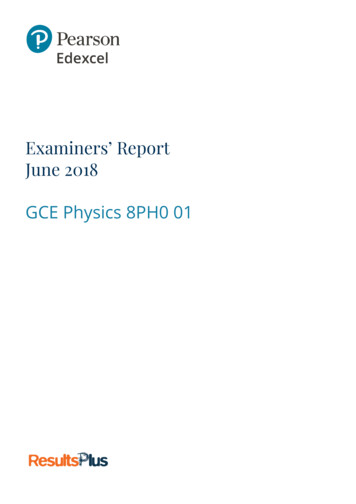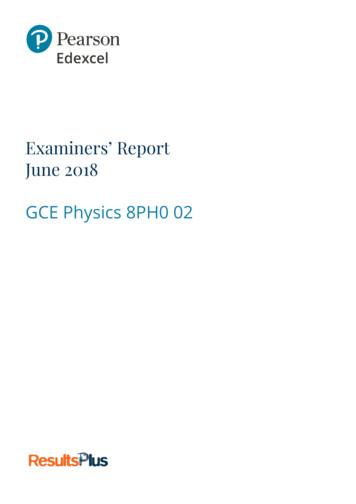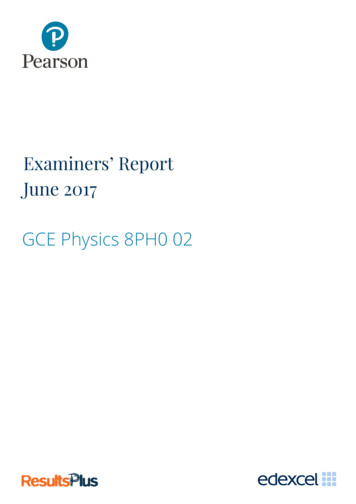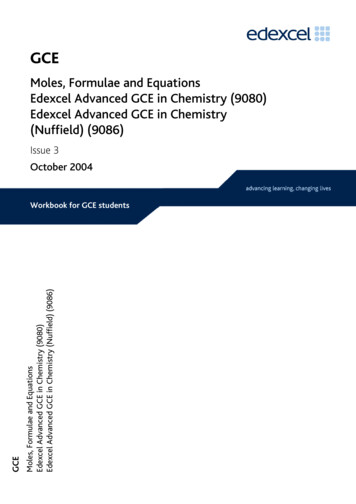
Transcription
Examiners’ ReportJune 2018GCE Physics 8PH0 01
Edexcel and BTEC QualificationsEdexcel and BTEC qualifications come from Pearson, the UK’s largest awarding body. We provide awide range of qualifications including academic, vocational, occupational and specific programmesfor employers. For further information visit our qualifications websites at www.edexcel.com orwww.btec.co.uk.Alternatively, you can get in touch with us using the details on our contact us page atwww.edexcel.com/contactus.Giving you insight to inform next stepsResultsPlus is Pearson’s free online service giving instant and detailed analysis of your students’exam results.See students’ scores for every exam question.Understand how your students’ performance compares with class and national averages.Identify potential topics, skills and types of question where students may need to develop theirlearning further.For more information on ResultsPlus, or to log in, visit www.edexcel.com/resultsplus.Your exams officer will be able to set up your ResultsPlus account in minutes via Edexcel Online.Pearson: helping people progress, everywherePearson aspires to be the world’s leading learning company. Our aim is to help everyone progressin their lives through education. We believe in every kind of learning, for all kinds of people,wherever they are in the world. We’ve been involved in education for over 150 years, and byworking across 70 countries, in 100 languages, we have built an international reputation for ourcommitment to high standards and raising achievement through innovation in education. Find outmore about how we can help you and your students at: www.pearson.com/uk.June 2018Publications Code 8PH0 01 1806 ERAll the material in this publication is copyright Pearson Education Ltd 20182GCE Physics 8PH0 01
IntroductionThis is the third time that the Pearson Edexcel AS paper 8PH0-01, Core Physics I, has been sat bystudents. Section A of the paper is worth 60 marks and consists of 8 multiple choice questionsfollowed by 6 questions of increasing length comprising of short open, open-response, calculationand extended writing style questions. Section A examines material from the topics Working as aPhysicist, Mechanics and Electric Circuits. Section B is worth 24 marks on this paper and examinesmaterial from the whole AS specification. It contains two questions worth 10 and 13 marksincluding a data analysis question based on an experiment to measure the speed of sound in air.Although this is not a core practical, it is similar to core practical 6 so it should be a context familiarto students from both their GCSE and their AS courses. The second question in section B was asynoptic question based on a liquid-crystal display.This paper enabled students of all abilities to apply their knowledge to a variety of styles ofexamination questions. Many students showed a good progression from GCSE to AS level, withprior knowledge extended and new concepts taught and understood well. With the exception ofquestion 9(b), most students answered the questions involving calculations ranging from 2 to 4marks very well. Question 9(b) was only answered correctly by the most able learners, as many didnot grasp the concept that the resistance of the voltmeter would decrease the resistance of theparallel branch of the circuit. Some questions were not answered as well as would have beenexpected by many learners; this was particularly evident in the open response and the extendedwriting questions. Learners that had a sound understanding of the physics involved did not alwaysdemonstrate this in their responses due to a lack of precision when applying their knowledge to thecontext, poor use of subject specific language and missing the point of the question due to beingunfamiliar with the command terms. However, learners from across all ability ranges alwaysmanaged to score some marks within these questions.Timing was an issue for a small number of learners, usually due to spending a disproportionateamount of time answering the multiple choice items. 16(c) was mostly affected by this issue withmany learners not spending sufficient time reading the stem and thinking about their response.GCE Physics 8PH0 013
Section A - Multiple choice questions 1-8Only the top end learners were able to score at least 7 on the multiple-choice items. Whilst E gradelearners scored, on average, 4 marks for these items. For middle ability learners and below, theperformance with these items was not indicative of their overall performance in the exam. This isusually due to a disproportionate amount of time spend on the multiple choice items, particularlyfor less able learners, taking time away from the higher scoring questions later in the paper.QuestionSubjectPercentage oflearners whoanswered correctlyMost commonincorrect response1SI base units45B2Trajectory of aprojectile77C3Resistance andtemperature in ametallic conductor81C/D4Current-potentialdifference graphs forknown components56A5Percentage uncertainty 48A/B6Kinetic energy andwork done58B7Core practical to28determine the e.m.f. ofa cellB8Calculation todeterminedisplacementA46Question 1As is common with multiple choice items at the beginning of the paper, some learners do notanswer as expected due to rushing though this first item on the paper. Surprisingly some very ablelearners dropped a mark as well and all would be advised to always re-visit this question if time isavailable. Some missed the instruction for SI base units and selected A or C, both giving correct SIunits but not SI base units. The most common error was to miss the power of -1 and selectedresponse B, A s-1 i.e. assuming it was giving A s, which is charge correctly quoted in SI base units.Question 2The range cannot increase for a projectile launched at the same speed at a greater angle, if theoriginal angle is greater than 45 . Distractors A and C are for projectiles launched at a greater angle,at greater speed. For the same launch speed, a greater angle can only reduce the range.4GCE Physics 8PH0 01
Question 3This multiple-choice question was answered more successfully than most of the other multiplechoice questions and only a small proportion failed to appreciate that, due to the increasednumber of collisions between charge carriers and lattice ions, the average distance betweencollisions will decrease and therefore the drift velocity will also decrease and not increase. A smallnumber of learners confused this model with that of a thermistor, selecting response D, anincreased number of conduction electrons per unit volume.Question 4The graph given was perhaps presented in a less familiar way to learners in that it was of potentialdifference against current rather than the other way around. Hence many thought it to be thegraph for a diode due to the sudden increase in the gradient, selecting distractor A, diode.Question 5The uncertainty for each measurement using the metre rule is 1 mm so with a measurement of 93cm the percentage uncertainty will be (0.1/93) x 100 0.1 %. The majority of errors were due to notmultiplying by 100 or confusion with unit conversions.Question 6Another multiple response answered well, the majority of errors occurred when learners saw theterm ‘work done’ and assumed that they have been given the force and the distance over which theforce was applied and just multiplied together the two quantities given. This was a verystraightforward question, only requiring use of the formula for kinetic energy and would have onlybeen answered incorrectly due to the speed at which the learner read through the question.Question 7Question 7 was based on core practical 3 to measure the internal resistance of a cell. The vastmajority of learners realised that the parallel circuits given in distractors C and D were incorrect,but many were confused about the addition of a second resistor in the circuit and where tosubsequently place the voltmeter. The remaining learners did not remember that the potentialdifference being measured must represent the output voltage of the cell and therefore thevoltmeter must be connected across any components within the circuit and not just one.Question 8This question was intended to test the learners’ understanding of displacement. The most commonincorrect response was A, the distance travelled around ¾ of the internal circumference of thetrack. The displacement of the athlete is the shortest distance from the start position to the endposition which could be calculated using Pythagoras ( (302 302) 42 m).GCE Physics 8PH0 015
Question 9 (a)Specification point 36 requires learners to be able to derive the equations for combiningresistances in both series and parallel. While it was very clear that many centres had covered this indetail, some learners still omitted steps or tried to work backwards with most recalling the endpoint of this derivation, the equation for the total resistance. The start point for all should havebeen the conservation of energy and a statement that the EMF of the cell was equal to the sum ofall the individual potential differences in the circuit. Applying Ohm’s law for each term should haveled to a cancellation of the currents and a final expression for the total resistance in the circuit.The question stated that the internal resistance of the cell is negligible, but some learners chose tostart their derivation using V E - Ir, which did not lead anywhere so many accompanied theirresponse with a statement of the total resistance, as the end point was clearly known.This response scored just 1 mark.6GCE Physics 8PH0 01
The learner clearly knew the equation for the totalresistance for resistors in series but did not know where tostart the derivation for this equation as no attempt wasmade to derive it.To derive the total resistance for resistors in series, youneed to start with a statement using the conservation ofenergy Vtotal V1 V2 V3 and then use Ohm's law for eachterm.To deive the total resistance of resitors in parallel, youneed to start with a statement using the conservation ofcharge, Itotal I1 I2 I3 and then use Ohm's law for eachterm.GCE Physics 8PH0 017
This response scored 2 marks, MP1 and MP3.The learner started off correctly, using the conservation ofenergy to obtain a statement of the total potentialdifference across the components is equal to the EMF ofthe cell. They then divided the individual voltages by thecurrents rather than replace each potential differenceusing Ohm's law, therefore this method did not lead themto the correct statement.The learner, did however state the correct equation at theend which allowed MP3 to be awarded. There was nojustification for this but the marking points wereindepenedent.8GCE Physics 8PH0 01
Question 9 (b)Very few learners managed to answer this question successfully. Those who correctly calculated aresistance of 240 W usually used the potential divider formula to obtain the total resistance of theparallel branch. They then successfully used the formula for the total resistance in a parallel circuitto obtain the resistance of the voltmeter.Some learners did manage to score 1 mark for using Ohm’s law with the p.d. across the voltmeterand what they thought to be the current in the voltmeter. Less able learners ignored the 1.85 V andassumed that the voltage was split 2V and 4V across the resistors, ignoring any reduction in theresistance due to the resistance in parallel of the voltmeter. Many could not correctly determine thecurrent through the voltmeter, assuming that the current through the 40 W resistor was 0.05 A(6/120).This response scored all 3 marks.GCE Physics 8PH0 019
The learner used a ratio of the resistance R across theparallel section compared to the total resistance, 80 R,with the p.d. across the parallel section compared to thetotal p.d. (i.e. the potential divider equation) to determinethe total resistance of the parallel circuit, leaving theiranswer as a fraction. This is fine for interim calcualtionsbut not for the final answer.They then used the equation for the total resistance ofresistors in parallel to determine the resitance of thevoltmeter.10GCE Physics 8PH0 01
This was a more typical response scoring just 1 mark for MP2, using the alternative marking route(the 'Or') on the mark scheme.The learner has assumed that the total resistance of theparallel section of the circuit is 80 Ω and has ignored thefact that the voltmeter has its own resistance. They thenused Ohm's law to calculate an incorrect value for thecurrent in the circuit. They then assumed that this is alsothe current in the voltmeter and used Ohm's law again,this time with the correct p.d. across the voltmeter todetermine what they think is the resistance of thevoltmeter.GCE Physics 8PH0 0111
Question 10 (a)This short open response gave the learners no direction as how they should approach theirexplanation. Only learners that took a mathematical approach, identifying the angle to refer to andforming an equation in terms of the tension and the weight of the picture were successful. Somelearners did try to answer in terms of stress and extension in the wire and were rarely successful inpicking up any marks. Only the most able learners managed to resolve the vertical forces and statemg Tcos θ as they took into account the factor of two for the tension in each half of the wire andgave the correct equation mg 2Tcos θ . More learners answered in terms of sine, using the angleto the horizontal, while a small number did not define θ by drawing this onto the diagram ordescribing it within their answer. Some good responses used sensible values substituted into theequation to demonstrate that the first arrangement produced a lower tension.This response did not score any marks.12GCE Physics 8PH0 01
Although the learner has resolved correctly for the tension,the vertical component of tension has not been equated tothe weight, or more correctly, to half of the weight.Therefore they had no basis for their subsequentdiscussion and no marks could be scored.You need to consider all of the forces acting on a systembefore any conclusion can be made about the size of anindividual force.GCE Physics 8PH0 0113
This response scored all 4 marks.Starting with a correct equation for the resultant force,tension (weight/2)/sinθ, enabled the learner to correctlydescribe the effect of increasing the angle θ i.e. make acomparison between arrangement 1 and arrangement 2.Leading to the correct conclusion that arrangement 1 ismore suitable as it produces a lower tension.14GCE Physics 8PH0 01
This response scored 2 marks.Unfortunately this learner forgot that there are effecivleytwo tensions that should be equal to the weight and thefactor of 2 was not included in the equation for theresultant force and MP2 could not be awarded. Thelearner did go on to make a sensible statement about agreater angle resulting in a lower tension and arrangement1 being more suitable. There was no justification as to whya smaller angle would result in a lower tension i.e. greaterθ so sinθ is greater, so no MP3 here.GCE Physics 8PH0 0115
Question 10 (b)Learners were required to use the idea of moments to explain why the system was not inequilibrium in arrangement 1 and why the system settled in the position in arrangement 2. Manyresponses only defined a system in equilibrium with balanced moments without applying any oftheir response to the two arrangements and a smaller number assumed that arrangement 2 wasnot in equilibrium, and effectively gave a description for the two arrangements the wrong wayround.Learners that attempted to explain the perpendicular distance between the line of action of theweight and the pivot mostly forgot to refer to a force and just referred to there being aperpendicular distance without adding further explanation. Marking points 1 and 3 were the mostgenerously worded and therefore the most frequently awarded and, although MP2 was not seen asoften, the physics involved was clearly known by most learners. A lack of detail therefore preventedmany from scoring MP2 in that they referred to a moment but did not state which force wascausing the moment or refer to both the clockwise and anti-clockwise moments.This response scored no marks.16GCE Physics 8PH0 01
Stating the principle of moments was not applying anyphysics to the context and did not help the learner answerthe question.Unfortunatley this learner assumed, as did many, thatarrangement 2 was the image not in equilibrium.Therefore no credit could be given. Had the points madebeen describing MP1 then MP1 and MP2 could have beenawarded.Read the question, these are unfamiliar contexts, howeversimple they seem, so that a key piece of information is notmissed. Every piece of information, particularly in the caseof 1Q0(b), is given for a reason so you should take note ofall of the information given.GCE Physics 8PH0 0117
A good response scoring all 3 marks.MP1 was scored for lines 1-2 for indicating that the weightnow has a perpendicular distance from the pivot.MP2 was awarded for the idea that the weight now has amoment in line 8.MP3 was awarded for a description of the picture inequilibrium in line 9.18GCE Physics 8PH0 01
Question 11 (a)Learners in the majority of cases answered this very well with the majority scoring all four marks.Learners only got into difficulty, often without realising, if they tried to determine the initialdirection based on the horizontal and vertical distances travelled during the first half of the motionof the ball, which also produced an initial direction of 21 .MP1 was the most commonly awarded for seeing the initial horizontal velocity of 25 m s 1 , whilesome less able learners then went along the distance route from here, sometimes mixing a velocityand a distance in their final calculation with tan to obtain a direction.This response scored all 4 marks.GCE Physics 8PH0 0119
The initial horizontal velocity of 25 m s—1 has beencalculated. The initial vertical velocity was then determinedusing s ut 1/2at2 giving the correct value of 9.81 m s—2.Finally the learner used tan (launch angle) 9.81/25 givinga launch angle of 21o.This response scored 2 marks.20GCE Physics 8PH0 01
The learner calculated correctly the initial horizontalvelocity of 25 m s—1 and then used v u at to determinethe initial vertical velocity. Using a final velocity of 0 meantthat they were only considering the motion up to themaximum height. The time taken to reach this height is 1second and not 2 seconds as the student has used here.Therefore the initial vertical velocity was incorrect and MP2could not be awarded.The learner did go on to use these two velocities correctlyto determine the launch angle. MP3 could be awarded butnot MP4 as the final answer was incorrect.This question requires use of s,u,v,a,t equations.Always list any values you have for any s,u,v,a,t quantitiesand make sure that they correspond and are for the sameparts of the motion of the projectile e.g. entire motion orjust motion to the maximum height.GCE Physics 8PH0 0121
Question 11 (b)This was another calculation question answered well by most learners. Some chose to ignore theinstruction to draw a labelled vector diagram and used trigonometry, usually successfully, todetermine the resultant force and direction. Such a method negated MP1 and MP2 as although thecorrect answers were obtained, part of this question was examining the students’ ability toconstruct correct vector diagrams. The vast majority though did draw out a vector diagram, toscale, usually labelling the 2 N and 9 N forces as required by MP1. Many able learners however,could not score MP2 due to omitting directions that are a requirement of a vector diagram and thiswas most commonly for the resultant force. Just to note as well, a small number of learnersproduced an answer slightly out of range, even with a correctly scaled vector diagram because theinitial angle between the 2 N and 9 N forces was not measured out accurately enough in the initialconstriction of the vector diagram.22GCE Physics 8PH0 01
2 marks awarded.GCE Physics 8PH0 0123
No vector diagram has been constructed so no MP1 andMP2 awarded.The learner resolved the 9 N force into x (horizontal) and y(vertical) components, subtracted the x components togive the resultant horizontal force and then usedPythagoras to determine the resultant force andtrigonometry to determine the direction of the initial force.MP3 and MP4 only awarded.If a scaled vector diagram is requested, you must use thisas your method to determine the quantity being asked forin the question. This is a seperate skill and you are beingexamined on this as well as your ability to reach the final,correct answer.24GCE Physics 8PH0 01
3 marks awarded for this response.GCE Physics 8PH0 0125
A vector diagram has been drawn to scale and themagnitude and direction have been measured accuratelyfrom the diagram giving answers in range.MP2 was the only marking point that could not beawarded as the direction for the resultant force was notdrawn onto the vector diagram.Vector diagrams must be to scale and show the directionof every vector included, including the resultant.26GCE Physics 8PH0 01
This was a good response scoring all 4 marks.GCE Physics 8PH0 0127
A correct scaled vector diagram, including all directions,has been drawn. Measurements have been taken givingvalues for the magnitude and direction of the resultantforce at launch in range.28GCE Physics 8PH0 01
Question 12 (a)Question 12(a) required learners to use the principle of conservation of momentum to determinethe velocity of the gliders after the collision. The physics being examined is no more challengingthan would be found on a GCSE level, however the omission of the mass confused many.While a large proportion of responses included the momenta of the gliders before the collision,with 0.7m and 0.3 m seen, these values were either added or learners did not know what to do withthem and just left their answer as 0.4 m s 1.Only a small number of learners correctly identified the momentum after the collision as 2mv andcould successfully obtain a final velocity of 0.2 m s 1. Some learners that only answered in termsof velocity i.e. 0.3 – 0.7, omitting the mass and not progressing any further, were not able to scorean interim working markdue to this incorrect method. The quoted direction of the gliders after thecollsions was usualy correct with learners appreciating the significance of the negative sign in theircalclated velocity.GCE Physics 8PH0 0129
A good response scoring all 3 marks.Right has been taken as the postivie direction and thestudent has a correct expression for the total initialmomentum of - 0.4 mv. This has been equated (due to theconservation of momentum) to the total final momentumof 2mv leading to a velocity of 0.2 m s 1 i.e. 2 m s 1 to theleft.30GCE Physics 8PH0 01
A more typical response, scoring 1 mark.GCE Physics 8PH0 0131
This time motion to the left has been taken as positive. Thestudent has correctly stated that the final momentum is0.4m but has not equated this to the expression for thefinal momentum in terms of the final velocity i.e 0.4m 2mv. The value quoted on the answer line is not thevelocity, the mass being dropped from the expression forthe final momentum.Only MP1 for use of p mv could be credited.32GCE Physics 8PH0 01
Question 12 (b)Question 12(b) asked learners to complete the incomplete explanation, justifying the change ofvelocity of glider 1 after the collision. Many answers included statements of Newton’s 1st and 3rd lawwithout applying them to the context of the gliders. Other responses were incomplete anddescribed equal and opposite forces on glider 1 and glider 2, often identifying that this was anapplication of Newton’s third law, but failing to identify the origin of the forces i.e. which object wasapplying these forces. At this point, a fair number of learners went on to discuss glider 2 and notglider 1, as the question had requested. Those that identified that there was now a resultant forceon glider 2, often linked this to Newton’s 2nd law and not the 1st law. Marks were therefore notscored as expected with many scoring just 1 mark and only the most able scoring 3 marks or more.This response scored just 1 mark.GCE Physics 8PH0 0133
MP3 was awarded for the idea that there is now aresultant force acting on glider 1. This is stated in line 2and the last line.The statement has not been completed and the studenthas only addressed the change in velocity of glider 1, asmentioned in the stem.To get from a force on one object to a force on a secondobject during a collision Newton's 3rd law must beconsidered. Therefore, as a starting point a responseshould always be broken down into which object isapplying the force and the object which the force is appliedto.34GCE Physics 8PH0 01
This response scored 3 marks.GCE Physics 8PH0 0135
This learner has clearly completed the statement,describing each object applying a force and which objecteach forces is applied to, leading to a discussion of justglider 1 and its resulting motion.MP4 was the only mark not awarded as the learnerreferred to Newton's 2nd law for the change in velocity (andhence direction) of glider 2 and not Newton's 1st law.Newton's 3rd law is between two objects so both need tobe mentioned.Newton's 1st law is just looking at the resultant force actingon one object and the motion as a result of this resultantforce.36GCE Physics 8PH0 01
Question 13 (a)This question required students to apply their knowledge and understanding of resistance andresistivity to resistivity surveying. Both questions 13(a) and 13(b) demonstrated a soundunderstanding of these concepts, with the majority of students scoring full marks over the questionas a whole.The vast majority of students linked an increase in length to an increase in resistance to gain MP2.A large number of students could then succesfully link an increase in resistance to an increased p.d.and hence increased reading on the voltmeter. A small number of students attempted to gain MP2through describing the system as a potential divider.The most common error was due to an apparent misunderstanding between the p.d. that thevoltmeter reads and the energy lost by electrons. These students generally recognised that therewould be a larger voltage drop, however, stated that this would cause the voltmeter reading todrop too.GCE Physics 8PH0 0137
A good response scoring both marks.A clear statement that the resistance is increasing so thevoltage will also increase has been included.38GCE Physics 8PH0 01
One mark scored for a description, effectively three times, of MP1.The student has not explained why the voltmeter readingwould increase. Just stating that the p.d. has increased isnot adding any more to the explanation as it does notjustify the increase in p.d. across the length BC.GCE Physics 8PH0 0139
Question 13 (b)As was seen with question 11(a), students generally performed the calculations very well. Themajority of students scored all 4 marks for calculating the resistance of the soil for each given p.d.,determining the resistivity and selecting from the table a possible material in the soil sample. Asmall number did reverse working to show the given voltages linked in a range using the upper andlower limits for the resistivity of each material. This reverse method was also valid, however, somestudents did not use a range and picked a midpoint in the resistivity range or a max/min resistivity.Therefore, without a range of p.d.s to choose from, they could not state with absolute certaintywhich materials were used and only MP1 and MP2 for use of the two formulae could be credited.A good response scoring all 4 marks.40GCE Physics 8PH0 01
The student has used V IR with the given current andvoltmeter reading and R ρl/A with the calculatedresistance to determine resistivities of 164.207 Ω m and731.95 Ω m.These values were then compared to the ranges ofresitivities in the table and compacted clay and limestonewere correctly selected as the materials in the soil.GCE Physics 8PH0 0141
This response scored 2 marks, MP1 and MP4.42GCE Physics 8PH0 01
Ohm's law has been used correctly to obtain a value forthe resitance of the soil given the two voltmeter readings.An incorrect substitution was then made into the resistivityequation, with the length and area the wrong way round.Therefore the calculated values of resitivity are incorrect.The student however, still made a selection from the tablebased on their two incorrect resistivities and as as theirconclusion was consistent with these values they wereable to score MP4.Always write out an equation before you substitute into itand double check you have transferred it correctly fromthe list of equations at the back of the question paper.The mark awarded is given is for a substitution into anequation, even if the quantity you are finding is not thesubject of the equation. Therefore, if you make a mistakere-arranging the equation, you can still get credit for thesubstitution.GCE Physics 8PH0 0143
Question 14 (a)The vast majority of candidates attempted to determine the area under the curve to obtain a valuefor the total distance travelled. Incorrect methods seen involved calculating the area under thegraph up to the current land speed record of 341 m s 1 while others carried out a simple d v x tcalculation with the maximum velocity or 341. Although such methods were incorrect, studentswere still able to attain MP3 for a comparison of their distance to 23 km. Those who approximatedthe area under the graph to two triangles obtained a value greater than 23 km, but MP1 and MP3could still be awarded for the method and the comparison.Not all students that carved u
This is the third time that the Pearson Edexcel AS paper 8PH0-01, Core Physics I, has been sat by students. Section A of the paper is worth 60 marks and consists of 8 multiple choice questions followed by 6 questions of increasing length comprising of short open, open-response, calculation and extended writing style questions.










